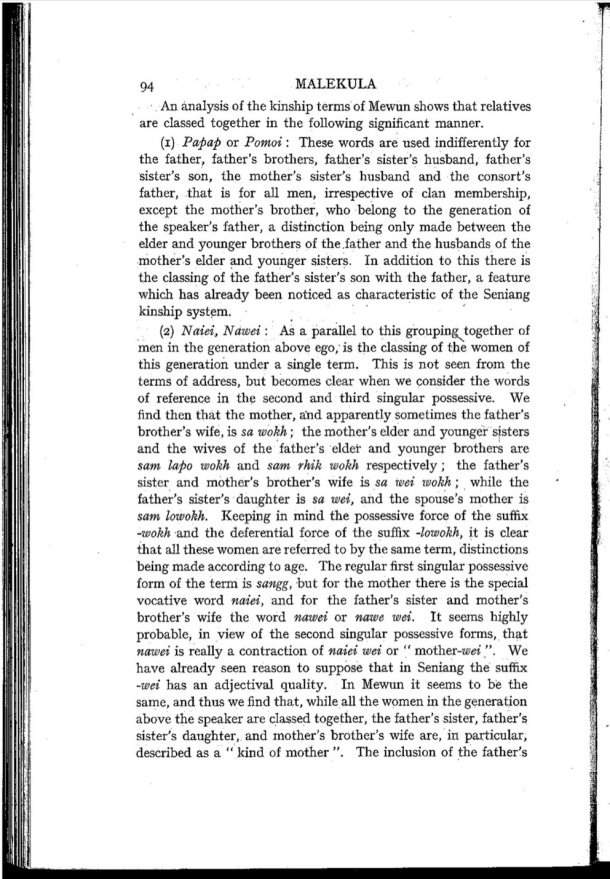|
|  [Note: this transcription was produced by an automatic OCR engine]
l~
94 MALEKULA
An analysis of the kinship terms of Mewun shows that relatives
are classed together in the following signiï¬Åcant manner.
(1) Pajiap or Pvmoi : These words are used indifterently for
the father, father's brothers, father's sister's husband, father's
sister's son, the mother’s sister's husband and the cunsort's
father, that is for all men, irrespective of clan membership,
except the mother's brother, who belong to the generation of
the speaker’s father, a distinction being only made between the
elder and younger brothers of theiather and the husbands of the
mother's elder and younger sisters. In addition to this there is
the elassing of the father's sister's son with the father, a feature
which has already been noticed as characteristic of the Seniang
kinship system. V '
_ (2) Naiei, Nawei : As a parallel to this groupingtogether of
men in the generation above ego," is the classing of the women oi
this generation under a single term. This is not seen from the
terms of address, but becomes clear when we consider the words
of reference in the seoond and third singular possessive. We
ï¬Ånd thcn that the mother, and apparently sometimes the father's
brother's wife, is sa wokh; the mother's elder and younger sisters
and the wives of the ‘father's elder and younger brothers are
sam lapo I/1/ukh and sum rhik wokh respectively; the father's
sister and mother's brother's wife is sa wei wokh; while the
father's sister's daughter is sa wei, and the spouse's mother is
sum lowokh. Keeping in mind the possessive force of the suffix
-u/okh -and the deferential force of the suiï¬Åx -lowokh, it is clear
that all these women are referred to by the same term, distinctions
being made according to age. The regular ï¬Årst singular possessive
form of the term is sangg, but for the mother there is the special
vocative word mziei, and for the father's sister and mother’s
brother's wife the word nau/ei or mm/B Wei. It seems highly
probable, in view of the second singular possessive forms, that
nawei is really a contraction of naiei u/ei or “ mother-wei ". We
have already seen reason to suppose that in Seniang the suffix
~wei has an adjectival quality. In Mewun it seems to be the
same, and thus we ï¬Ånd that, while all the women in the generation
above the speaker are classed together, the father's sister, father's
sister's daughter, and mother’s brother's wife are, in particular,
described as a " kind of mother ". The inclusion of the father's
‘ 1'!
.4
ft
|